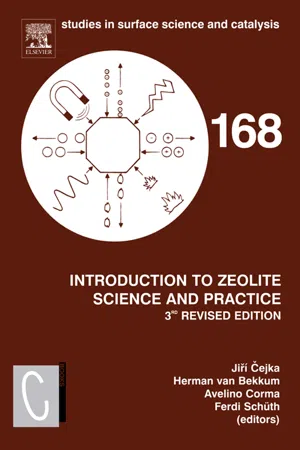
Introduction to Zeolite Molecular Sieves
- 1,094 pages
- English
- ePUB (mobile friendly)
- Available on iOS & Android
Introduction to Zeolite Molecular Sieves
About this book
Introduction to Zeolite Molecular Sieves, 3rd Edition presents a collection of the most important results and ideas in the field of molecular sieve chemistry and technology, the most important experimental techniques related to the research activities in molecular sieves, and identifies new areas of molecular sieve chemistry. Chapters start at a reasonably simple entry level, but also covers the present state-of-the-art in the field. Topics covered include structure, synthesis, characterization, ion exchange, adsorption, diffusion, separations, and natural zeolites.* 6 years since the last edtion this book brings together the rapid development within the field of molecular sieve chemistry and applications * Accessible to newcomers to the field, also containing valuable information for experienced researchers * 27 chapters written by renowned scientists in their field, including updates on some 2nd edition chapters
Frequently asked questions
- Essential is ideal for learners and professionals who enjoy exploring a wide range of subjects. Access the Essential Library with 800,000+ trusted titles and best-sellers across business, personal growth, and the humanities. Includes unlimited reading time and Standard Read Aloud voice.
- Complete: Perfect for advanced learners and researchers needing full, unrestricted access. Unlock 1.4M+ books across hundreds of subjects, including academic and specialized titles. The Complete Plan also includes advanced features like Premium Read Aloud and Research Assistant.
Please note we cannot support devices running on iOS 13 and Android 7 or earlier. Learn more about using the app.
Information
Table of contents
- Cover image
- Title page
- Table of Contents
- Copyright page
- Preface to the 3rd Edition
- Chapter 1: The Zeolite Scene – An Overview
- Chapter 2: Zeolite Structures
- Chapter 3: Synthesis of Zeolites
- Chapter 4: Phosphate-Based Molecular Sieves: New Structures, Synthetic Approaches, and Applications
- Chapter 5: Organic Molecules in Zeolite Synthesis: Their Preparation and Structure-Directing Effects
- Chapter 6: Zeolite Membranes – Synthesis, Characterization and Application
- Chapter 7: Synthesis of Delaminated and Pillared Zeolitic Materials
- Chapter 8: The Synthesis of Mesoporous Molecular Sieves
- Chapter 9: Micro/Mesoporous Composites
- Chapter 10: Hybrid Porous Solids
- Chapter 11: Diffraction Techniques Applied to Zeolites
- Chapter 12: Solid-State NMR Spectroscopy in Zeolite Science
- Chapter 13: Infrared and Raman Spectroscopy for Characterizing Zeolites
- Chapter 14: Structural Study of Porous Materials by Electron Microscopy
- Chapter 15: Textural Characterization of Zeolites and Ordered Mesoporous Materials by Physical Adsorption
- Chapter 16: Ion-Exchange Properties of Zeolites and Related Materials
- Chapter 17: Gas Adsorption in Zeolites and Related Materials
- Chapter 18: Host–Guest Interactions in Zeolites and Periodic Mesoporous Materials
- Chapter 19: Molecular Modelling in Zeolite Science
- Chapter 20: Applications of Quantum Chemical Methods in Zeolite Science
- Chapter 21: Diffusion in Zeolite Molecular Sieves
- Chapter 22: Acid and Base Catalysis on Zeolites
- Chapter 23: Applications of Mesoporous Molecular Sieves in Catalysis and Separations
- Chapter 24: Zeolites in Hydrocarbon Processing
- Chapter 25: Catalyst Immobilization on Inorganic Supports
- Chapter 26: Progress in the Use of Zeolites in Organic Synthesis
- Chapter 27: Natural Zeolites and Environment
- Index
- Studies in Surface Science and Catalysis